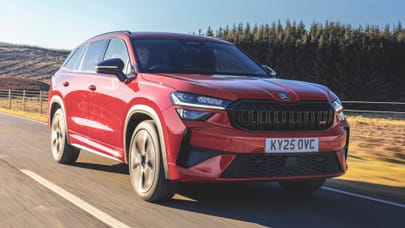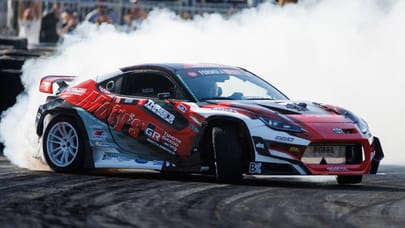
Behold, the Dacia Sandrider: a 355bhp road-legal Dakar car set for 2025
Dacia wants to win next year’s Dakar rally, but to do so it’s going to need a lot more than a Duster…
Wait, what? Dacia’s entering the Dakar rally?
Oh yes! It announced its plans in 2023. Not only that, it announced its drivers. Eight time Dakar competitor and rally hero Sebastian Loeb, 2024 Dakar T3 category winner Cristina Gutiérrez, and five-time Dakar winner Nasser Al-Attiyah will be in the (very) hotseat of a Sandrider. The Romanian company isn’t messing about when it comes to the talent behind the wheel.
What’s a Sandrider then?
The future winner of the Dakar rally, of course! Well… that’s what Dacia hopes, and it’s given itself a decent chance by partnering with motorsport engineering legends Prodrive. Prodrive’s Rally Raid Special, the Hunter, will form the car’s basis, all rigged up to get Dacia into the top Ultimate T1+ class. That means a 3.0-litre twin turbo V6 with 360bhp and 397lb ft, 350mm of suspension travel, a lightweight tubular chassis, 17in wheels shod in 37in tyres, carbon bodywork, and all the trimmings to, hopefully, give everyone else a run for their money.
How come it doesn’t look like a Duster?
Frankly, because it would look weird. David Durand, Dacia’s design boss, was rather firm that he didn’t want a Duster campaigning in the sand - no one would believe the car’s a Duster when it’s 2.3 metres wide, which caused some relief at Prodrive too.
“They were immediately, like: ‘Whew!’ They were worried we’d ask for an existing design that doesn't fit at all with their package, and it’d be a fight. We said, 'no, no, no. We’ll follow your lead. We want to win'," Durand said. It follows the lead of Dacia’s Manifesto concept, which is… definitely not a Duster.
It looks cool, but is any of it actually, y’know, useful?
If you’re well versed in Dacia lore you’ll know that there are three pillars to the brand: 'Essential but Cool', 'Robust and Outdoor', and 'Eco Smart'. The last one’s covered by the use of synthetic, Earth-friendly fuels, the second… it’s a freaking Dakar car, so it should be able to handle a hill or two, but it’s the first that really stands out here.
Its angular design is actually useful for generating downforce and reducing lift. The front with its funky bonnet spoiler has three routes for air to go - over the top of the car to the spoiler, over the car to the rear deck, and out through the front wheel arch to feed a mid-mounted radiator. Dacia reckons it’s achieved a 10 per cent reduction in drag, and 40 per cent in lift compared to its competitors.
Working with the drivers has been key - the team has asked them for real, useful feedback before building the car, so there’s a better chance of it being bang on straight out the gate. The drivers wanted easy access to spare tyres for inevitable punctures, so rather than hide them away, the design team had them neatly secured by a massive strap.
Kevin Bouvier, the Sandrider's exterior designer, explains why. “Before, the engineers wanted a panel to protect the tyre, but actually the tyre’s more solid than a carbon fibre panel. Hit one rock, the panel’s smashed. And you can get fined if you leave parts in the desert. Applying the Dacia DNA to it, it's like: if we don't need a panel, let's get rid of it. Plus, there’s direct access to the spare wheel, so it's a win-win. Fewer parts, less weight, and more efficiency.” In fact, thanks to losing unnecessary panels it’s 15kg lighter than comparable cars. Or so Dacia says.
While the wheel’s being changed far from help, or a flat surface, there’s a high chance that bolts, screws, and whatever will be dropped and lost in the desert… unless you happen to have a magnetic panel to stick them to. “Instead of risking losing bolts in the sand, you stick them to the car. There’s no special technology, just simple solutions," Bouvier said.
What happens if they get stuck and need a sand board? There are two clipped to the rear of the car, and space for four more in the Sandrider’s fold down ‘boot,’ which doubles as a table when it’s open to act as a workspace.
Top Gear
Newsletter
Thank you for subscribing to our newsletter. Look out for your regular round-up of news, reviews and offers in your inbox.
Get all the latest news, reviews and exclusives, direct to your inbox.
Why’s there’s a floating bit on the front?
The drivers wanted as big a vertical angle as possible to see what’s going on - as such they have 11 degrees of forward visibility from their seats, some of which is through the lower hood gap. Dunes can be steep. “When the drivers go down the dune they have to see the exit point and so on," Bouvier said. "We tried to bring the most functionality. That's why we decided to have a floating bonnet. We already offer good visibility over the bonnet, but we decided if we can bring extra, let's go for it.”
Why isn’t it white like a load of other Dakar cars?
It’s true that white cars keep themselves cooler in the sun, but Dacia’s got a special IR tincture baked into the car’s carbon panels that keeps the temperature down by about 35 degrees. Romain Gauvin, Dacia's chief of advanced design, elaborates. “We patented a new material - an infrared-resistant carbon fibre. It reflects infrared, so no heat, no need to paint the car white, no need for white carbon fibre. The end result is even better thermal management for the drivers.”
What about the cabin? What’s that all about?
Some of Dacia’s initial modelling will make it to the finished car, others, thanks to regulations, will not. While Dacia’s seats and steering wheel designs are cool, the FIA wants everyone to have things it knows are safe, so out with the cool stuff and in with the ‘we know this won’t break you’ things. The rest though… that’s all staying. With three highly skilled drivers on board, they each have their own way of doing things, and as Dacia wants them to be comfortable and, er, win, the cabin needs to work for all of them.
The solution came not from 2024, but from a Dieter Rams modular stereo from the 1970s, explains Théo Courtefois, Sandrider interior designer. “With the system from the 70s you could make everything modular. If you want something, you can add it.” A smart solution to keep everyone happy.
That’s smart, but what else is in there?
Dacia has a VR setup to show the drivers, and TG, what the cabin will look like. You jump into a wooden buck, slot a wheel in front of you, and enter a virtual world. From where we were sitting the cabin felt like an idealised future version of a race car. Carbon fibre was everywhere, as well as lots of buttons - but not as many as you’d think as some are neatly hidden away.
While the seats will be FIA-issue, they’ll be covered in a smart (and easy to clean) fabric, which is better at temperature management and wicking away moisture. Drivers’ bums will be less sweaty, basically. For on the road storage, drivers asked for easily accessible sealed bags to stop things from rolling about, and there’ll be room for six litres of water in there as well.
Are there any Easter eggs? There better be…
The Dacia logo on the roof is pretty cool. How else will you spot the Sandrider from the air? Less of an Easter egg and more a practicality - the Sandrider is fully road-legal, so its dinky headlights and cyclops lamp work to road car specification. We also need to give a nod to whoever designed the team kit - as well as the best looking car in the desert, Dacia will have the most stylish team.
When are we going to see this thing move then?
After testing in various bits of the world, the Sandrider will debut in the Rallye du Maroc in October 2024. After that it’s off to the 2025 Dakar rally and then the rest of the World Rally-Raid Champs.
Can I get some raw stats?
Of course you can.
FIA Category: Ultimate T1+
Chassis: tubular
Body: carbon fibre
Engine: V6, 3.0-litre, twin-turbo, direct injection
Maximum power: 265 kW/355bhp at 5,000 rpm
Maximum torque: 398lb ft at 4,250 rpm
Transmission: 4X4
Gearbox: six-speed sequential
Front/Rear Suspension: double wishbone
Suspension Travel: 350mm
Wheels: 17in aluminium rims
Tyres: 37in BF Goodrich
Length x Width x Height: 4,140 x 2,290 x 1,810 mm
Wheelbase: 3,000 mm
Front/rear overhang: 590/550 mm
Trending this week
- Electric
Top Gear's top 20 electric cars















